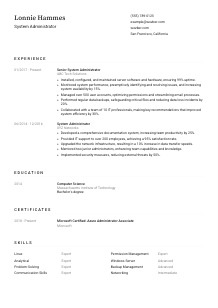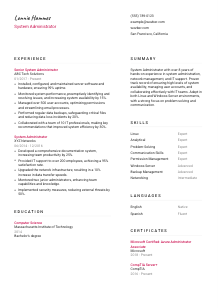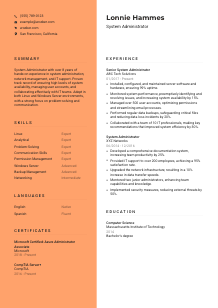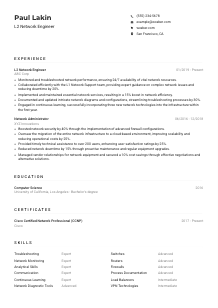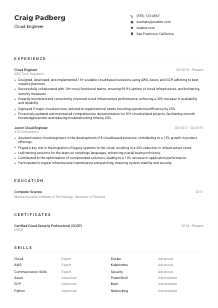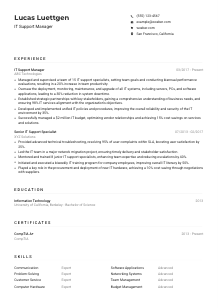System Administrator Resume Example
Mastering networks, but your resume seems offline? Navigate this System Administrator resume example, booted with Wozber free resume builder. Discover how to thread your IT expertise into job-critical cables, ensuring your career stays connected and not caught in a crash loop!
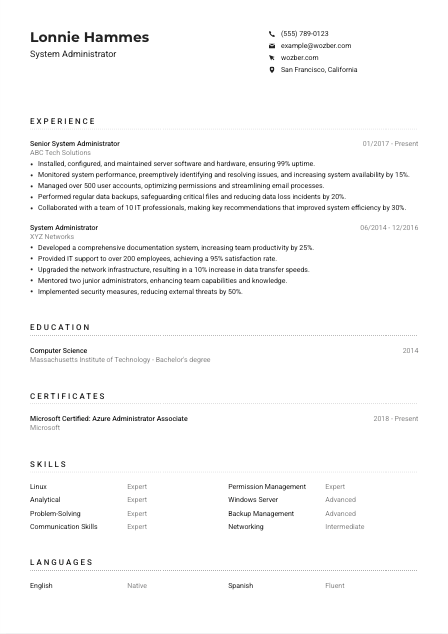
How to write a System Administrator Resume?
As a System Administrator, you are the spine of IT operations, ensuring the company's digital heartbeat pulses strong and steady. Yet, even the most skilled System Administrator knows that landing the perfect role is all about how effectively you present your expertise on your resume. Today, we dive into the art of assembling a standout System Administrator resume, tailored meticulously to your dream job.
Leveraging Wozber's free resume builder, ATS-compliant resume templates, and ATS resume scanner for optimization, you're steps away from a resume that commands attention. Let's gear up, sharpen those pencils (or rather, keyboards), and craft a resume that opens doors.
Personal Details
Just as the correct IP configuration is crucial for system access, offering the right personal details sets the initial tone for your resume. Craft this section with precision to ensure you're instantly seen as a promising candidate for the System Administrator role you're eyeing.
1. Brand Yourself Right at the Outset
Your name isn't just a label; it's your professional banner. Ensure it's prominently displayed in a clear, professional font. Adjacent, align your title with the job you're applying for - "System Administrator" directly below your name tells the hiring manager you're confident in your role.
2. Direct Communication Lines
Your contact information is your direct line. Include a phone number that's always within reach and a professional email address, ideally in the firstname.lastname@email.com format. Accuracy is critical, ensuring you're readily contactable for that interview call.
3. Match the Geographic Protocol
The job description requesting someone in or willing to relocate to San Francisco, CA isn't a minor detail. By listing "San Francisco, California" in your resume, you signal alignment with logistical preferences, cutting through the first layer of candidate filtration.
4. Link to Your Professional Network
In today's digital age, including a LinkedIn profile is akin to providing a gateway to your professional persona. Ensure it's updated to reflect your resume. This not only demonstrates thoroughness but also positions you as a modern, connected System Administrator professional.
5. Keep it Professional and Relevant
While personal hobbies and interests can add character, this section is best kept for professional and contact details only. Stay focused on what matters to this job application: your capability to excel as a System Administrator in San Francisco, CA.
Takeaway
With your personal details neatly laid out, your resume's initial configuration is set. This introductory section isn't just about your contact info; it's an opportunity to assure the hiring manager you're a definite contender, right from the start. Done well, it propels them to delve deeper into your technical expertise and professional achievements.





Experience
In the experience section, you have the power to demonstrate your direct alignment with the System Administrator role's responsibilities and requirements. Every bullet point should echo your expertise, achievements, and the value you've brought to previous positions. Let's detail how to narrate your professional journey in a way that resonates with hiring managers.
- Installed, configured, and maintained server software and hardware, ensuring 99% uptime.
- Monitored system performance, preemptively identifying and resolving issues, and increasing system availability by 15%.
- Managed over 500 user accounts, optimizing permissions and streamlining email processes.
- Performed regular data backups, safeguarding critical files and reducing data loss incidents by 20%.
- Collaborated with a team of 10 IT professionals, making key recommendations that improved system efficiency by 30%.
- Developed a comprehensive documentation system, increasing team productivity by 25%.
- Provided IT support to over 200 employees, achieving a 95% satisfaction rate.
- Upgraded the network infrastructure, resulting in a 10% increase in data transfer speeds.
- Mentored two junior administrators, enhancing team capabilities and knowledge.
- Implemented security measures, reducing external threats by 50%.
1. Decrypt the Job Description
Pour over the job description to identify key skills and responsibilities. For instance, the requirement for "monitoring system performance and troubleshooting issues" should be reflected in how you outline your past roles, mirroring the language to ensure ATS optimization.
2. Structure Your Professional Network
Adopt a reverse-chronological format, leading with your most recent System Administrator position. This familiar structure allows hiring managers to quickly gauge your career progression and current expertise level.
3. Highlight Command-Line Successes
For each position, draft accomplishment-oriented bullet points. Whether you boosted system availability by 15% or managed over 500 user accounts, quantify your achievements. This tangible proof of your impact makes your resume stand out.
4. Deploy Quantifiable Metrics
Whenever possible, equip your accomplishments with numbers. Increased system efficiency by 30%? Reduced data loss incidents by 20%? These metrics serve as benchmarks of your success, offering a clear, quantitative view of your contributions.
5. Filter Out Irrelevant Data
Resist the urge to list every job you've ever had. Focus on experiences that showcase your suitability for the System Administrator role. This strategic pruning makes your resume a lean, mean, candidate-selecting machine.
Takeaway
Your experience section is essentially a log file of your professional journey—one that the hiring manager needs to review to understand the depth of your system administration prowess. Present it with precision, ensuring each line proves why you are the ideal candidate for the role. A well-documented track of relevant experiences significantly boosts your chances of making it through the ATS filtering and onto the shortlist.
Education
While experience speaks volumes, your education section lays the groundwork, showing you have the formal training needed to understand the complex landscape of system administration. Here's how to ensure your academic background speaks directly to the requirements of your intended role.
1. Navigate to the Core Requirements
The job lists a "Bachelor's degree in Computer Science, Information Systems, or a related field." Your degree, especially if it matches verbatim, should be featured prominently, confirming you meet this fundamental criterion.
2. Compile Your Academic Credentials
Keep this section succinct yet comprehensive. List each degree in reverse-chronological order, including the field of study, the awarding institution, and your graduation year. This clarity reassures hiring managers of your academic qualifications.
3. Optimize Degree Details for the Job
If your degree aligns perfectly with the job's educational requirement, spotlight this alignment. For instance, a "Bachelor's degree in Computer Science" directly matches the specified need, instantly establishing your relevant academic foundation.
4. Feature Pertinent Academic Projects
Though not a substitute for professional experience, significant academic projects or coursework related to system administration can supplement your qualifications, especially if you're at the earlier stages of your career.
5. Certify Your Educational Achievements
If your academic journey includes honors or extracurricular involvement in tech clubs or societies, brief mentions can illustrate your passion and dedication beyond the classroom. However, gauge the relevance based on your overall career level.
Takeaway
Your education section is your baseline configuration, proving you have the theoretical knowledge and foundational skills essential for a System Administrator. With this section precisely tailored, you affirm to hiring managers and ATS algorithms alike that your qualifications are in perfect sync with the role's requirements. It's another firm step towards securing that interview.
Certificates
In the tech world, where evolution is constant, certifications act as badges of honor, showcasing your commitment to staying at the forefront of system administration. Here's how you can highlight your certifications to align with the job you want.
1. Match Certificates with Job Necessities
The job description mentions "Relevant certifications such as Microsoft Certified: Azure Administrator Associate or CompTIA Server+ are a plus." If you hold these or related certifications, place them front and center to immediately catch the recruiter's eye.
2. Select Your Most Relevant Credentials
Prioritize listing certifications that speak directly to the skills and knowledge the job requires. This targeted approach ensures that your resume doesn't become cluttered with less relevant accolades.
3. Specify Issuance and Validity Period
Detailing when you earned each certification and noting any expiry dates demonstrates the currency of your expertise, a critical factor in fast-evolving technical fields like system administration.
4. Stay in Continuous Learning Mode
The tech landscape never stands still, and neither should you. Continuously seeking out new certifications not only enhances your skill set but also shows prospective employers your dedication to professional growth.
Takeaway
Your certificates are the external validation of your skills, proving your technical prowess and specialization. Sharply curated and prominently featured, they tell hiring managers you're not just meeting the baseline but exceeding expectations with your dedication to professional development. It's a compelling argument in your favor, powerfully complementing your experience and education.
Skills
The skills section of your resume is not just a list; it's a strategically selected array of your capabilities, deliberately matched to the job's requirements. Let's define how to engineer this section to make your System Administrator qualifications unmistakably clear and impressively relevant.
1. Sync with System Demands
Begin by distilling both explicit and implicit skills needed for the System Administrator role from the job description. Skills like "proficient in Linux and Microsoft Windows Server environments" directly map onto your resume, showing a perfect fit.
2. Prioritize Hard and Soft Skills
While technical capabilities are critical, don't overlook soft skills. For a System Administrator, strong "analytical, problem-solving, and communication skills" are as vital as expertise in specific software or systems.
3. Craft a Clear and Compelling List
Focus on listing skills that are most relevant to the job, categorizing them for clarity. Keeping this section precise and to the point shows you understand what the role entails and that you possess the competencies to excel.
Takeaway
A well-articulated skills section serves as a quick reference for hiring managers, confirming at a glance that you're equipped with both the technical and soft skills to thrive as a System Administrator. Tailored and tuned, this part of your resume underscores your candidacy's strength and suitability, positioning you as an ideal match for the dynamic challenges of the role.
Languages
In our interconnected world, language skills can significantly amplify your professional appeal, especially in diverse and global teams. Whether explicitly mentioned in the job requirements or not, your language proficiencies can be a distinguishing factor. Let's navigate how to articulate this segment for added leverage.
1. Address the Job's Language Specifications
When the job listing specifies, as ours does with the "must be adept at English language communication," ensure this requirement is clearly met in your resume. This ticks off a vital box right from the start.
2. Showcase Your Linguistic Toolkit
Beyond meeting the essential requirements, list any additional languages you speak and your proficiency levels. This doesn't just show linguistic skill but also speaks to your ability to thrive in multicultural environments.
3. Rank Languages by Proficiency
Organize languages from your strongest to least proficient, using clear terms like 'native,' 'fluent,' 'intermediate,' and 'basic.' This gives hiring managers a quick understanding of your linguistic capabilities.
4. Evaluate the Role's Global Reach
For roles that involve liaison with international teams or customers, emphasizing your language skills can be particularly persuasive. It demonstrates not just your communication skills but also your potential for broader roles.
5. Be Candid and Accurate
Honesty about your language proficiency levels is crucial. Overstating your abilities can lead to complications down the line, so provide a realistic snapshot of your language skills to set clear expectations.
Takeaway
Your language skills, neatly unpacked in your resume, underscore your capacity to communicate effectively and operate in diverse settings. This aspect of your professional profile can distinguish you from other candidates, highlighting your versatility and global mindset. In the context of system administration, where clarity and understanding are paramount, showcasing your language abilities could well be the factor that tips the scale in your favor.
Summary
The summary is where you encapsulate your expertise, experience, and professional aspirations. It's the teaser trailer to the blockbuster that is your career. Let's craft a compelling introduction that entices hiring managers to deep-dive into your System Administrator journey.
1. Capture the Essence of the Role
Start with a strong opening line that positions you as a dedicated and skilled System Administrator. Money sentences like 'System Administrator with over 8 years of hands-on experience' instantly communicate your relevance and readiness.
2. Highlight Your Technical Achievements
Pick a few of your most significant achievements that align with the job's requirements. Use this opportunity to showcase your contributions, such as 'ensuring 99% uptime' or 'increasing system availability by 15%,' that mirror the role's listed responsibilities.
3. Emphasize Your Professional Attributes
Integrate your soft skills alongside your technical ones to offer a rounded view. Mentioning your 'strong analytical, problem-solving, and communication skills' underscores your capability to handle the multifaceted challenges of system administration.
4. Keep It Clear and Powerful
Your summary should be concise yet impactful, capturing the essence of your professional persona in 3-5 lines. This snapshot encourages the hiring manager to continue reading, intrigued by your potential and eager to learn more.
Takeaway
A well-crafted summary is like the login screen to your resume – it invites the reader in, offering a glimpse of what's to come. It sets the stage for your application, highlighting your fit for the System Administrator role even before they dive into the details. Engage your audience from the start, and make them eager to explore your professional network and achievements. With this, your resume is not just a document; it's a compelling narrative of your career journey, waiting to be explored.
Launching Your System Administrator Path
Congratulations, you've now crafted a resume that not just speaks to your suitability as a System Administrator but sings it. Using Wozber's free resume builder, ATS-friendly resume template, and ATS resume scanner for optimization, you've equipped yourself with a tool that's designed to get noticed. Remember, your resume is your ticket to interviews; make it count. This is your moment, your launchpad.
Propel your career to new heights, and let your skills, experience, and passion for system administration speak volumes. The networks await your command!

- Bachelor's degree in Computer Science, Information Systems, or a related field.
- Minimum of 5 years of experience in system administration, network management, or IT support.
- Proficient in Linux and Microsoft Windows Server environments.
- Strong analytical, problem-solving, and communication skills.
- Relevant certifications such as Microsoft Certified: Azure Administrator Associate or CompTIA Server+ are a plus.
- Must be adept at English language communication.
- Must be located in or willing to relocate to San Francisco, CA.
- Install, configure, and maintain server software and hardware.
- Monitor system performance and troubleshoot issues to ensure high levels of system availability.
- Manage user accounts, permissions, email, and anti-virus software.
- Perform regular data backups to safeguard system files.
- Collaborate with IT teams and make recommendations for system improvements.





